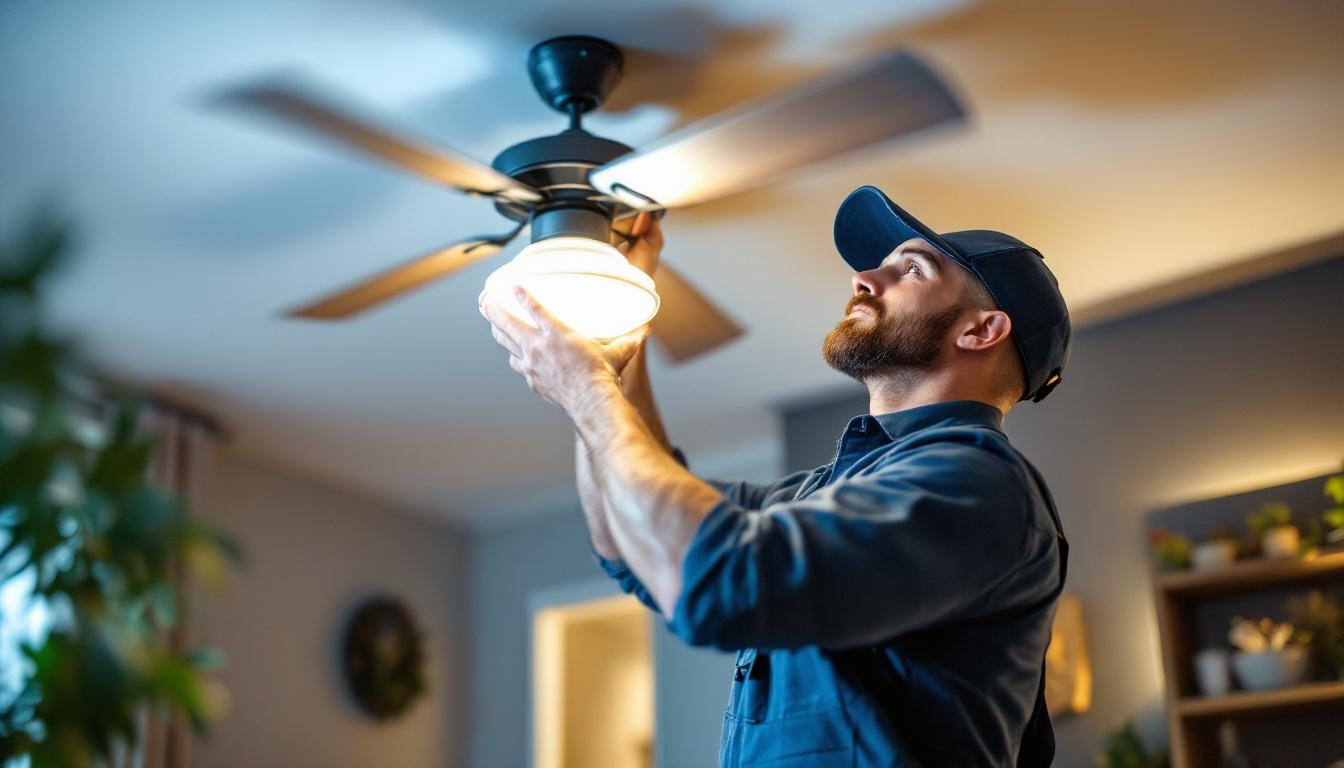
Ceiling fans are a staple in residential and commercial lighting and climate control solutions. For lighting contractors, understanding how to properly change a ceiling fan light kit is essential not only for functionality but also for safety and customer satisfaction. A well-executed light kit replacement can enhance the ambiance of a room, improve energy efficiency, and ensure compliance with electrical codes.
Given the variety of ceiling fan models and light kits on the market, contractors must be equipped with up-to-date knowledge and best practices. This handbook serves as a comprehensive guide to help lighting contractors navigate the complexities of ceiling fan light kit replacement, from preparation and tools to troubleshooting and finishing touches.
In addition to the practical aspects of replacing a light kit, it’s important to consider the aesthetic impact that different lighting options can have on a space. For instance, a sleek, modern light kit can transform a dated ceiling fan into a stylish focal point, while vintage-inspired designs can evoke a sense of nostalgia and warmth. Understanding the preferences of clients and the overall design theme of a room can greatly influence the choice of light kit, making it essential for contractors to stay informed about current trends in home decor and lighting design.
Moreover, the energy efficiency of the light kit plays a significant role in the decision-making process. With the increasing emphasis on sustainability, many homeowners are opting for LED light kits that not only consume less energy but also have a longer lifespan compared to traditional incandescent bulbs. Lighting contractors should be knowledgeable about the benefits of various lighting technologies and be prepared to educate clients on how these choices can lead to long-term savings on energy bills while also reducing their carbon footprint.
A ceiling fan light kit typically includes the lighting fixture that attaches to the fan, the bulbs, wiring harnesses, and mounting hardware. The light kit integrates with the fan’s electrical system to provide illumination while maintaining the fan’s aesthetic and functional integrity.
Light kits come in various styles—ranging from simple single-bulb fixtures to elaborate multi-light chandeliers. The choice of kit affects both the lighting output and the overall look of the fan, making it important for contractors to understand the options available. For instance, a sleek, modern light kit can enhance the contemporary feel of a space, while a vintage-style fixture may complement a more traditional decor. Additionally, the type of bulbs used—such as LED, incandescent, or CFL—can impact energy efficiency and the warmth of the light, further influencing the ambiance of the room.
One of the most critical factors in changing a ceiling fan light kit is ensuring compatibility. Different fan models have unique mounting brackets, wiring configurations, and electrical requirements. Installing an incompatible light kit can lead to mechanical issues, electrical hazards, or voided warranties.
Contractors should always verify the manufacturer’s specifications and consult the fan’s installation manual. Universal light kits exist but often require adapters or modifications. When in doubt, sourcing the original equipment manufacturer (OEM) light kit is the safest route. Furthermore, it’s essential to consider the wattage and voltage ratings of both the fan and the light kit to avoid overloading the electrical system. This attention to detail not only ensures safety but also optimizes performance, allowing homeowners to enjoy the full benefits of their ceiling fan and light combination. Additionally, some light kits come with integrated smart technology, enabling remote control and dimming features that can enhance convenience and energy savings, making them an attractive option for modern homes.
Before beginning a light kit replacement, lighting contractors should assemble a set of essential tools to ensure efficiency and safety. These tools typically include:
Having these tools at hand minimizes delays and helps maintain a professional workflow. In addition to these basics, it may also be beneficial to have a flashlight or work light available, especially if the installation area is poorly lit. A magnetic tool holder can also be a handy addition, allowing contractors to keep screws and small parts organized and within easy reach while working at height.
Working with ceiling fans involves exposure to electrical wiring, which can pose significant risks if mishandled. Contractors must always turn off the power at the circuit breaker before starting any work. Using a voltage tester to confirm the absence of current is a non-negotiable safety step.
Additionally, wearing insulated gloves and ensuring the work area is dry can prevent accidental shocks. Lighting contractors should also be aware of local electrical codes and regulations to ensure compliance and avoid liability. It’s also wise to keep a first aid kit nearby, just in case of minor injuries, and to have a buddy system in place when working in high or awkward positions. This not only enhances safety but also provides an extra set of hands for difficult tasks, making the entire process smoother.
Before removing the existing light kit, inspect the ceiling fan for any signs of wear or damage. Check the fan’s mounting bracket, wiring condition, and the integrity of the fan blades. Identifying potential issues early can prevent complications during installation and enhance the longevity of the new light kit.
Furthermore, it’s prudent to assess the overall environment in which the fan operates. For instance, consider the room’s humidity levels and temperature fluctuations, as these factors can affect the performance and lifespan of both the fan and the new light kit. If the fan is located in a kitchen or bathroom, moisture-resistant fixtures may be necessary to prevent corrosion and electrical issues. Documenting any findings during this assessment can also be beneficial for future reference or for communicating with clients about necessary upgrades or repairs that could enhance their lighting setup.
Begin by carefully removing any glass shades or decorative elements to access the mounting screws. Unscrew the light kit from the fan housing, taking care not to damage the wiring. Once the fixture is loose, gently pull it down to expose the electrical connections.
Disconnect the wiring by unscrewing wire nuts or disconnecting quick-connect plugs, noting the color coding and connection points. It’s advisable to take a photo or make a sketch for reference during reinstallation.
Match the new light kit’s wiring to the fan’s wiring harness, typically connecting black (hot) to black, white (neutral) to white, and green or bare copper (ground) to the grounding wire or screw. Secure connections with wire nuts and wrap them with electrical tape for added safety.
Carefully tuck the wires into the fan housing, then attach the new light kit to the mounting bracket using the provided screws. Ensure the fixture is firmly secured and properly aligned. Reinstall any glass shades or bulbs as specified by the manufacturer.
Restore power at the circuit breaker and test the light kit’s functionality. Verify that the light switches and fan controls operate correctly without flickering or unusual noises. If issues arise, turn off the power and double-check wiring connections and bulb compatibility.
Finally, clean the fixture and surrounding area to remove any dust or fingerprints, leaving the installation neat and professional.
Modern lighting contractors are increasingly focused on energy efficiency and sustainability. When changing ceiling fan light kits, consider recommending LED bulbs or integrated LED light kits. LEDs consume significantly less power than incandescent or halogen bulbs and offer longer lifespans, reducing maintenance calls.
Additionally, dimmable LED kits provide customers with greater control over lighting ambiance and energy consumption. However, ensure compatibility with existing fan controls and dimmer switches to avoid operational issues.
Clients often seek to personalize their ceiling fans to match interior design themes. Lighting contractors can add value by offering a range of light kit styles—such as vintage, modern, or transitional designs—and finishes like brushed nickel, bronze, or matte black.
Some advanced light kits also feature smart lighting capabilities, including color temperature adjustments and integration with home automation systems. Familiarity with these technologies can position contractors as forward-thinking professionals in a competitive market.
Despite careful installation, issues may occasionally arise. Common problems include flickering lights, non-functioning bulbs, or humming noises. Flickering often results from loose wiring or incompatible dimmer switches, while humming may indicate electrical interference or poor grounding.
Contractors should methodically isolate the cause by checking connections, testing bulbs, and verifying compatibility. Maintaining a troubleshooting checklist can expedite problem resolution and enhance customer trust.
Compliance with national and local electrical codes is mandatory for all lighting contractors. These codes govern wiring methods, grounding, fixture ratings, and installation practices to ensure safety and reliability.
Staying current with code updates and manufacturer guidelines protects contractors from legal liabilities and enhances their reputation. When in doubt, consulting with a licensed electrician or code official is advisable.
Proper documentation is a hallmark of professionalism. Contractors should record details such as the light kit model, bulb types, wiring modifications, and any customer preferences. Providing clients with maintenance tips and warranty information adds value and fosters long-term relationships.
Digital documentation tools and mobile apps can streamline this process, allowing contractors to generate reports and invoices efficiently.
Changing a ceiling fan light kit is a task that combines technical skill, safety awareness, and aesthetic judgment. For lighting contractors, mastering this process is vital to delivering high-quality service that meets client expectations and regulatory standards.
By understanding compatibility issues, preparing adequately, following systematic installation steps, and embracing modern lighting technologies, contractors can elevate their craft and expand their business opportunities. This handbook aims to be a trusted resource for lighting professionals committed to excellence in ceiling fan light kit replacement.
Ready to take your ceiling fan light kit installations to the next level? At LumenWholesale, we provide lighting contractors like you with the highest quality, spec-grade lighting products at prices that can’t be beaten. Our extensive selection is designed to meet the most rigorous industry standards, ensuring every project shines with reliability and excellence. Say goodbye to middleman markups and hello to hassle-free bulk buying with free shipping. Elevate your service offerings with the unbeatable value and convenience of Wholesale Lighting at the Best Value from LumenWholesale.

Discover the top extractor roof fans for gyms that offer quiet operation and enhanced efficiency, perfect for lighting contractors looking to optimize ventilation and energy use.

Discover the essential role of high bay LED shop lights in modern lighting installations.

Discover the fascinating history of the light bulb’s invention and gain valuable insights tailored for lighting contractors.

Discover the latest innovations in motion sensing porch lights that are transforming outdoor lighting solutions.